
This resource from the New York Times includes a variety of lessons, ideas, and resources to teach students to new vocabulary.
- Provider:
- New York Times
- Author:
- NY Times Learning Network
- Date Added:
- 06/24/2019

This resource from the New York Times includes a variety of lessons, ideas, and resources to teach students to new vocabulary.

This resource accompanies our Rethink 6th Grade ELA course. It includes ideas for use, ways to support exceptional children, ways to extend learning, digital resources and tools, tips for supporting English Language Learners and students with visual and hearing impairments. There are also ideas for offline learning.

This is an intermediate learning plan based on Unit 1 of the WordBuilder Vocabulary book. This particular resource will be used with an Advanced 6th Grade ELA class, as the vocabulary words are consiered to be at a 7th grade level. However, it could be used with a 7th grade class as well. Students take a pre-assessment, and their score dictates which sets of activities they need to complete, with the goal being to move them toward proficiency on the post assessment. This intermediate playlist was developed as part of a professional learning opportunity funded by the NCDPI Digital Learning Initiative Planning Grant.

This parent guide supports parents in helping their child at home with the 6th grade English Language Arts content.

The Adventurers of Sojourner presents a third-person narrative account of the Mars Pathfinder mission, which included the deployment of a small science rover named Sojourner. In this CCSS lesson, students will explore this history through text dependent questions, academic vocabulary, and writing assignments.
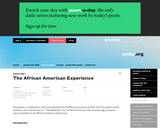
There is no one poem that represents the experience of African Americans in the United States, yet the history of racism in this country is seared deeply into the lives of many African Americans. “The Weakness” by Toi Derricotte recounts an experience with racism through the eyes of a young, light-skinned African American girl going shopping with her grandmother in a department store in 1945. The poems in The African American Experience offer a number of perspectives from African American poets that add a rich complexity to students’ perceptions of African American lives.

In Ray Bradbury's “All Summer in A Day†takes place on the planet Venus in a future world where people have come to set up a civilization. In this CCSS lesson students will explore this fiction story through text dependent questions, academic vocabulary, and writing assignments.
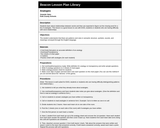
In this lesson, students will learn about relationships between words and will then be expected to figure out the missing word for a list of analogies.
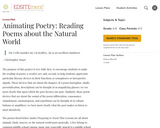
The purpose of this project is two-fold: first, to encourage students to make the reading of poetry a creative act; and, second, to help students appreciate particular literary devices in their functions as semaphores or interpretive signals. Those devices that are about the imagery of a poem (metaphor, simile, personification, description) can be thought of as magnifying glasses: we see most clearly that upon which the poet focuses our gaze. Similarly, those poetic devices that are about the sound of the poem (alliteration, consonance, enjambment, onomatopoeia, and repetition) can be thought of as volume buttons or amplifiers: we hear most clearly what the poet makes us listen to most attentively.

In this 14 day unit plan students read, research, draw conclusions, and write beginning level argumentative essays comparing/contrasting major world religions.

This lesson prepares students to be independent and responsible for their own just-right book selections during independent reading time. Using the BOOKMATCH poster, the teacher introduces various criteria that influence book selection, such as length, language, topic, and genre. Students select books for independent reading using several of these criteria. In subsequent lessons, they discuss and evaluate their book choices and are introduced to additional selection criteria. Ongoing support and practice lead to increased awareness of their personal preferences as readers.

The short story, titled “Becky and the Wheel-and-Brake Boys,†is about how Becky desperately wants to own a bike despite the resistance she is met with from her mother and Granny-Liz. In this CCSS lesson students will explore this short story through text dependent questions, academic vocabulary, and writing assignments.

This story, set in 1820s Austria, is a series of letters written between a young boy, Christoph, who lives in Vienna and his uncle, a music student who lives in Salzburg. In the letters, Christoph tells his uncle of the strange gentleman, Ludwig van Beethoven, who has rented a room in the boy’s home. In this CCSS lesson students will explore this story through text dependent questions, academic vocabulary, and writing assignments.
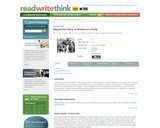
For this lesson, students are invited to attend a 19th Century party as a character from Charles Dickens' A Christmas Carol. To play this role, students must understand the values and customs Dickens' characters represented in Victorian society. This lesson is divided into three stages: Group Investigative Roles, Individual Characterizations, and Individual Presentations. Students collaboratively research the life and times of Charles Dickens as it relates to a character, and write and present a first-person character analysis.

Students will understand common Greek and Latin roots through participating in this engaging and interactive vocabulary game. Students will gain knowledge about word origins, and this knowledge and understanding will reinforce the connections among related words.

In this secondary source lesson on ancient Greek civilization, students will explore this story through text dependent questions, academic vocabulary, and writing assignments.
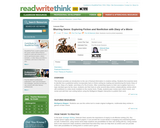
This lesson provides an introduction to the use of factual information in creative writing. Students first examine texts to identify how a published author incorporates facts in fiction writing by reading and questioning the books Diary of a Worm, Diary of a Spider, and Diary of a Fly (Cronin). After conducting inquiry on their own to gather facts on a topic decided upon by the class, students use their facts to write several diary entries collaboratively, entries which will contribute to a class book modeled on the mentor texts. Finally, students peer review each other’s work, and revise and edit their own writing before using the Multigenre Mapper interactive to publish their work.

In this alternative to the traditional book report, students have to really understand a character from a book they have read in order to successfully communicate the essence of the character using a few words and symbols on a business card. They begin by discussing the details commonly found on business cards and looking at samples. They think about how font, colors, and logos can be used to represent their characters, as well as the taglines, products and services, and other details that could be included. Students then use planning sheets to think through the elements they want to include on their business cards before creating the final version using a word processing program on the computer.

Students examine graphic novels and comic books and discuss the important components of the genre, such as captions, dialogue, and images. They then use an online tool to create a six-panel comic highlighting six key scenes in a book they have read. By creating comic strips or cartoon squares featuring characters in books, students are encouraged to think analytically about the characters, events, and themes they've explored in ways that expand their critical thinking by focusing on crystallizing the significant points of the book in a few short scenes.
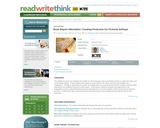
In this lesson, students are given the opportunity to be imaginative as they create illustrated postcards that depict one of the settings of their novel choices featuring journeys. Furthermore, they communicate about the importance of the settings as they write the text of their postcards.